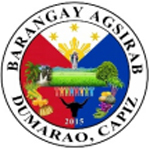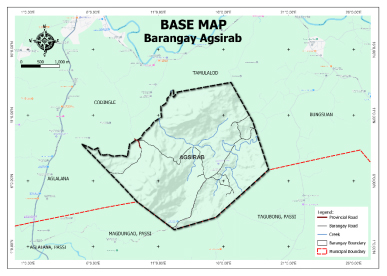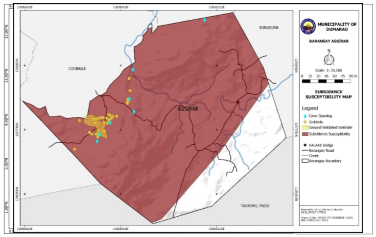Barangay Agrisab
 Barangay Agsirab is one of the barangay in the municipality of Dumarao. It is 14 kilometer away from the town proper. The nearest peak with in the eyeshot that will give the lasting impression for its novelty and color is Mt. Opaw, a natural formation of solid calcite rocks with plenty of lime and carbon deposits standing like an impregnable fortress guarding Agsirab’s northwestern entrance from Codingle. Two other peaks are equally natural wonders. Mt. Boundary, towering the above the eastern part of barrio which serves as the landmark that separates Agsirab from Brgy. Tagubong. In the northern part of the barrio is Mt. Tag.ao.
Barangay Agsirab is one of the barangay in the municipality of Dumarao. It is 14 kilometer away from the town proper. The nearest peak with in the eyeshot that will give the lasting impression for its novelty and color is Mt. Opaw, a natural formation of solid calcite rocks with plenty of lime and carbon deposits standing like an impregnable fortress guarding Agsirab’s northwestern entrance from Codingle. Two other peaks are equally natural wonders. Mt. Boundary, towering the above the eastern part of barrio which serves as the landmark that separates Agsirab from Brgy. Tagubong. In the northern part of the barrio is Mt. Tag.ao.
The Aeta or Negritos was the first group of people who settled in the barangay before the Spaniards colonized our country in 1521. Considering the fact that Aeta or Negritos are nomadic in nature some of them transferred to other places but there were few families who settled permanently in the barangay. The artifacts that have been discovered in 1972 such as gongs made of bronze, spears made of bronze and silver, plates, bowls, jars, necklaces and other earthen wares. The people of Agsirab who discovered the artifacts believed that our ancestors buried these in their burial place in a parcel of land which is currently owned by Mr. Abelino Procal. The Jars with the designs of the dragon and with Chinese characters served as a proof that our ancestors have engaged in barter trade with the Chinese.
After the settlement of the Aeta, his great grandfather named Silverio Aguilario had settled in the barangay during the Spanish era. The Aeta couple who dwelled in the barangay during the settlement of Mr. Silverio Aguilario was Eslao and Nieves. Other persons who also settled in the barangay during the Spanish regime were Hanojuaria Aguilario, Bautista Aguilario, Benigno Arevalo, Forferio Bardies, Regino Dichosa and Vencio Berry.
During the Spanish times, the Spanish government established a centralized government. The King of Spain issued a Royal Decree for the establishment of Pueblos and barrios. Each barrio was headed by a Teniente del Barrio (Cabeza de Barangay). Mr. Silverio Aguilario was the first Teniente del Barrio of Barangay Agsirab.
During his time, a group of men called hoodlums or Boyong in vernacular, have temporarily settled in the place in order to hide from the Spanish soldiers. They saw that the cogon grass, boho and zigzag bamboos, shrubs and other grasses in this place were burnt that’s why they called the place Agsirab from the word sirab which means burnt. From then on the dwellers of the barangay called the place Agsirab and became one of the barangays in the Municipality of Dumarao.
In 1942, Pedro “ Pantat” Aguilario became the second Teniente del Barrio of Brgy. Agsirab. He was the successor of his father named Silverio Aguilario. He was newly appointed to his position, when the Japanese invaded Capiz. He was one of the witnesses when the first air attack of the Japanese force in the Visayas took place on April 17, 1942. Chaos occurred during the Japanese invasion. Many persons have fled in mountains just to survive. Brgy. Agsirab was the hiding place of the people coming from Poblacion Ilaya, Poblacion Ilawod, cubi and Salcedo. During the Second World War, famine was rampant that’s why the people who hide in Brgy. Agsirab have been eaten ube, cassava, banana and other root crops just to survive. Some of the residents joined in the guerrilla forces and fought against the Japanese forces. At the end of the World War II, the persons who hide in the barangay returned to their respective places while the residence of brgy. Agsirab enjoyed their freedom.
In 1946, Agsirab Primary School now Agsirab Elementary School was founded and the first teacher was Mr. Huqueriza.
In 1957, the longest serving Teniente del Barrio was appointed as Teniente del Barrio and later the term Teniente del Barrio was changed to Brgy. Captain and elections was held. In 1967, Mr. Jalandoni purchased the land from Mr. Locsin. Mr. Jalandoni established hacienda RBM and in the same year the Sitio RBM was created. The name of the sitio came from the name of Hacienda RBM (Rub, Benjie and Manuling). During the operation of Sitio RBM, there was a boom in the field of Agriculture in the brgy. There was an increase in sugarcane production as well as many agsirabnons have been employed and resulted to the progress of the entire barangay. Moreover, feeder roads and barangay roads were improved.
In 1974, the St. Rosary Chapel was built. The chapel was made of light materials such as cogon grass and bamboo. In 1989, Mr. Regalado Saldo Aguilario was elected as Brgy. Captain of Brgy. Agsirab. He was re-elected for several times and served until 2007. In 1993, the Brgy. Covered Gymnasium was constructed. The Energization Project of Congressman Castro was implemented in year 2000 and the people of the brgy. Enjoyed the comfort of living brought by the Electrification Project.
In 2007, Mr. Jamehil Bardies Gonzales, Sr. was elected as Barangay Captain. He spearheaded the implementation of their prioritized project such as;
a. Road Upgrading
b. Construction of New Barangay Hall
c. Water System
d. Botica sa Barangay
e. Semi- Concrete Classroom
f. Expansion & improvement of covered gym
The barangay had also won the first place in the Gulayan sa Barangay Contest in year 2009.
As the time passes by, the transformation of the Barangay continues. Now the Barangay is the leading producer of fruits and vegetables in the municipality of Dumarao. Many infrastructures are sprawling in the Barangay Proper.
The Agsirabnons has rich culture and the place is incomparable. The barangay is really a beautiful and peaceful place, a better place to live in.
Barangay Agsirab is one of the upland barangay of the Municipality of Dumarao, in the province of Capiz. It has a total of 10,061.6 square kilometers.
The barangay has an agricultural area of 334.14 hectares, 33.21% of its total land area. The agricultural products like palay (paddy rice), corn, sugarcane, coonut, mango, vegetables and banana plantation are present in this barangay.
Barangay Agsirab Summary Data


Geo- physical Hazards
Agsirab is exposed to 2 types of hazards: rain-induced landslides with 3 susceptibility levels: high, moderate, and low, and KARST Subsidence.
An area of 527.73 hectares or 30.71% of the total land area has a high susceptibility level for rain-induced landslide. Moderately susceptible have an area of 169.42 hectares or 16.84%, while 309 hectares or 30.71% have low-level susceptibility.
A portion of the barangay is susceptible to high subsidence having an area of 838.02 hectares or 83% of the total barangay land


Demographics
Household
The household population of Agsirab in the 2020 Census was 1,228 broken down into 303 households or an average of 4.05 members per household.
Population by age group
According to the 2020 Census, the age group with the highest population in Agsirab is 15-19, with 13.36% or 164 individuals. On the other hand, the age group with the lowest population is 75-79, with 0.90% or a total of 11 individuals.
Combining age groups, those aged 14 and below, consisting of the young dependent population which includes infants/babies, children, and young adolescents/teenagers, make up an aggregate of 29.72% (365). Those aged 15 up to 64, roughly, the economically active population and actual or potential members of the workforce, constitute a total of 64.58% (793). Finally, the old dependent population consisting of the senior citizens, those aged 65 and over, total 5.70% (70) in all.
Historical population
The population of Agsirab grew from 715 in 1990 to 1,228 in 2020, an increase of 513 people over the course of 30 years. The latest census figures in 2020 denote a positive growth rate of 1.37%, or an increase of 77 people, from the previous population of 1,151 in 2015.
Adjacent barangays
Agsirab shares a common border with the following barangay(s):
- Codingle, Dumarao, Capiz
- Tamulalod, Dumarao, Capiz
- Aglalana, Passi, Iloilo
- Aglalana, Dumarao, Capiz
- San Juan, Dumarao, Capiz
- Magdungao, Passi, Iloilo
- Tagubong, Passi, Iloilo
- Bungsuan, Dumarao, Capiz

